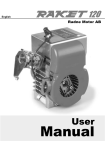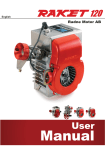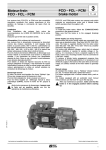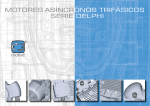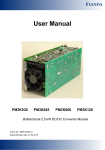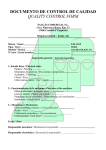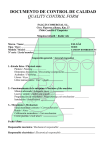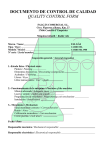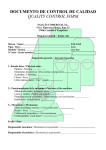Download Manual Raket 60 English
Transcript
English Radne Motor AB Users Manual User s Man ual Users Manual Intr oduction Introduction We at Radne Motor congratulate you to your choice of the Raket 60 go-kart engine. With this manual we will try to give you hints regarding the running and the maintenance of your new engine. It is our sincere hope that your new engine will give you lots of fun and very little problems. If you follow our simple instructions in this manual you can avoid many costly mistakes. T he Cadet g o-kar lass go-kar o-kartt c class lass.. In many countries there is a Cadet class for the very youngest go-kart drivers. In Sweden, for instance, the Cadet class is open for drivers between 8 and 10 years of age. For this class we have prepared a special Raket 60 version which has been homologated by the Swedish Automobile Sport Federation. In other countries it may be different. But where the Raket 60 engine has been homologated, it is important that you know exactly how every part of the engine must look like, because you must not make any modifications to the standard engine. For this reason we have written the “Product description“. The National Karting Authority that has made the homologation has normally issued an “Homologation form“, and you should read the Homologation form and the Product description together. The homologation form includes drawings with all important measures which can be checked during a racing event. In countries where Raket 60 isn’t homologated yet for a Cadet class, the engine may be used for other purposes, e.g. for Rental karting or just for Karting-for-Fun. For whatever purpose you own and drive your Raket 60 engine, you will find the parts labelled “To the new owner of a Raket 60 kart engine“ and “Service advice“ valuable reading. Our very best advice to you if you are a beginner in the go-kart sport is to join a gokart club. In the club you will find people who can share their experience with you, and the club may offer courses for new drivers and new mechanics. If you intend to race, you must be member of a go-kart club, because you will need a racing license, which only your club can issue. Welcome to the world of karting. We at Radne Motor have been in the business for 35 years, and we have enjoyed every minute of it. We do hope that you also will find karting to be “your cup of tea“. ! For conversion of millimetres to inches - 1 mm corresponds to 0,03937 inches. © Radne Motor 1997 - Revision 2 1997-04-01 2 User s Man ual Users Manual About the R ak et 60 engine Rak aket The Raket 60 engine is produced by Radne Motor AB in Sweden. It is the Radne Motor AB together with its agents who take the responsibility for the sale and service of the Raket 60 engine and who assist all karters who are using the engine to get the maximum performance and fun out of it. Pr oduct description Product 1. The cr ankcase crankcase The crankcase must have the same shape as is shown in the homologation form. The measures that are especially important are those for the parts of the crankcase which surround the crankshaft. These measures must not be changed. 4150 Crankcase The part of the crankcase which surrounds the flywheel must also remain unchanged (no machining allowed). The part of the crankcase which is closest to the drive sprocket must remain unchanged, with the exception that is acceptable to make necessary modifications at the outside in order to be able to fit a suitable guard over the sprocket and chain. The oilsealing rings are “free” i.e. you can change the make as long as the type and the size remain the same. They must be 15x26x7 mm with both a sealing lip and a dust cover lip. The ball bearings (they normally stick on the crankshaft when you disassemble the crankcase) are in original SKF 6202 bearings. They are “free” in respect to the make, but must be of deep groove ball bearing type and be mounted at the same place as the original. 4092 Vevaxel 2. T he cr ankshaft and connecting rrod od crankshaft No machining of any kind or any other modification of the crankshaft is allowed. You must not change the balancing of the crank shaft through machining or addition of material. You must not machine or modify the connecting rod in any way. 3 User s Man ual Users Manual The needle bearings at both ends of the connecting rod are “free” in respect to the make, but must be of the same type as the original bearings (a needle bearing in a steel cage). 3. T he c ylinder and the spar kplug cylinder sparkplug The cylinder must remain totally unmodified i.e no machining of any kind is allowed. For instance, deburring the edges of the cylinder ports is regarded as machining and is therefore not allowed. The sparkplug is “free”. If the thread in the cylinder for the sparkplug should be damaged, it is accepted to repair it with a thread set of HeliCoil type or similar. 4. T he piston It is only the original piston that you are allowed to use, without any kind of machining or modification. The piston is always marked with the name of the manufacturer (Radne), but other markings on the crown of the piston may vary. The piston rings the gudgeon pin and the clips are “free”, i.e may be changed to similar parts of another make, as long as the measures remain the same as for the original parts. 5. Standar d par ts Standard parts Gaskets, nuts, bolts, screws and washers are standard parts and as such they are “free”. 4 4087 Piston complete User s Man ual Users Manual 6. T he carb ur ettor carbur urettor The carburettor must be original Tillotson, series HS. No modifications are allowed. 3048-1 Carburettor The venturi (the most narrow part of the channel through the carburettor) must have a diameter of maximum 17.7 mm. The diameter of the channel closest to the carburettor manifold must be 20.5 mm. The following external modifications of the carburettor are allowed: - you may make the modifications needed for fitting the throttle cable, but only under the circumstance that it has no effect on the function of the carburettor - you may change the gasoline inlet nipple 7. T he carb ur ettor manif old carbur urettor manifold This part may under no circumstances be machined. Deburring is regarded as machining. 8. Cylinder co ver cov The cylinder cover is standard for Raket 60. It must not be machined, more than to make it fit well to the engine. You may also make an hole in the top for a decompression valve 9. T he ignition system The ignition system is of a transistorised type, and is especially developed for Raket 60. It must not be changed against any other type or make of system. It is further forbidden to move the ignition system from its original position. In some countries is the ignition equipped with a rev restriction, which cuts the ignition at 9800 revs. Note! Apart from the fact that it is forbidden to machine the flywheel, it is also very dangerous. If you machine the outer perimeter of the flywheel, it might explode when you run the engine at high revs. 10. The ffllyw heel ywheel The flywheel must be original Raket 60 and marked with Radne and the part number 5018023. The height of the flywheel fins must be 35 mm. The only machining which is acceptable is what may be required to balance the flywheel. The minimum weight 5 User s Man ual Users Manual is 400 grams. The flywheel key is free. It is acceptable that you machine it and also that you remove it completely. 11. Air filter Must be Raket 60 original, and always fitted to the engine. 12. Exhaust system Must be Raket 60 original. Some countries use catalytic converter, and if so the converter must be well functioning. 13. The c hain spr oc ket chain sproc ock The chain sprocket on the drum of the centrifugal clutch must have 11 teeth and be of type 219. 14 . Star ter Starter The engine shall be equipped with standard starter. The starter cover may not be machined, the measure and the shape shall be according to the picture in the homologation form. Starter rope and the starter handle can be changed to other brand, though it is not a recommendation. Caution!! The length of the starter rope is important for the life length of the starter spring. Standard length is 110 cm. 15. Centrifug al c lutc h Centrifugal clutc lutch All parts in the centrifugal clutch: hub, clutch, clutch drum, clutch spring and special nut and the sirclip must be original. The most important reason for this rule is safety. The clutch is a safety part, and every change or modification of the clutch can jeopardise the safety. Furthermore, in countries where the Raket 60 engine is homologated, every action taken to change the speed at which the clutch is engaged is regarded as illegal and hence forbidden. 6 " Caution! The silencer with surroundings will be very hot. Avoid touching when hot. User s Man ual Users Manual To the new owner of a Raket 60 kart engine Please read the following two pages. It will take you perhaps 15 minutes, but it can save you a lot of aggravation and money in the future. When you read the following pages you will find numbers that refer to the exploded view on page 16. Numbers in the text with six digits are sparepart numbers engraved into the part in question. All four digit numbers are our own part numbers. See the spareparts list on pages 15. Mounting the engine on the kart For this purpose we have developed a special engine mount for the Raket 60 engine which makes the mounting to the frame very simple. The part number for the engine mount is 3004. Our engine mount will not fit karts with another spacing between the two frame members than what is common on karts today. If the engine mount doesn’t fit, we recommend that you use the engine mount that belongs to your kart and that you machine it to fit the Raket 60 engine. When you have mounted the engine to the frame, you must link the carburettor with the accelerator. We have made a special throttle linkage (no 3083) which makes it easy to do this. We recommend that you have an extra return spring that helps to close the throttle, in order to make sure that the throttle closes every time you release the accelerator. Finally, you connect the fuel hose to the carburettor. Use a transparent, flexible hose and make sure it cannot rub off. Tie it to the chassi with plastic straps. 7 User s Man ual Users Manual Exhaust The Raket 60 is homologated with silenser 4140, and no other silenser can be used. The silencer is equipped with catalytic converter. It is especially developped for Raket Go-kart engine and cleans the up to 70%. The silencer will be very varm, up to 1200° inside. You can never repair a damaged silencer, it has to be exchanged. Check if your city has a special deposit for silencers Efficiency: with catalytic converters. HC 60-65% " NOx Test rrun un CO If you have mounted the engine on the kart according to the description, you are now ready for your first test run. You don’t need to worry about the gearing, because the engine is designed to operate with only one gearing ration - 11 teeth on the engine and 90 teeth on the rear shaft. Note, where the Raket 60 engine is homologated for a Cadet class, this is the only gearing ratio allowed. If you use the Raket 60 engine for any other purpose, we still recommend you to use the 11/90 gearing, as this is the ideal gearing for which the engine is designed. Oil the chain with a special oil or grease for chains, and don’t forget to mount a guard over chain and sprockets - remember SAFETY FIRST! You shall ALWAYS have the inlet air filter mounted on the engine. If you race in a homologated class it is compulsory to have the filter in place, and even if you don’t race in a homologated class, you should use the inlet air filter anyhow, because it keeps sand, dust and water out of the interior of the engine. This can save you expensice repairs. Fuel. Raket 60 is intended for unleaded fuel, we recommend 98 octane fuel, with a 3% mixture with two stroke oil. We don’t recommend the use of so called outboard oil. The engines can also be run on two stroke oil for extremely low mixture (1%). If you chose this alternative, we must recommend you the utmost care when preparing the fuel and oil mixture. You should use packages of oil intended for 5 or 20 liters. 8 80-85% 0-20% User s Man ual Users Manual # Note, don’t use so called racing oil (castor oil), because it doesn’t mix well with petrol. If you leave the mixture in the tank it may well separate again which can lead to engine damage. Hint: Do always mix you own fuel and always use fresh and clean Ho w to star How startt the engine engine.. petrol cans. OK, time to start the engine. Check once again that everything is mounted according to the instructions. Close the choke trottle, put you foot on the frame of the kart, grip the starter handle with BOTH hands and pull the handle straight up. NOTE, pull hard but don’t jerk. If everything is in order, the engine will start on the first pull. As soon as the engine starts, you must open the trottle a little. Hold down the brake and give some trottle. Now open the choke and release the accelerator. If everything is OK, the engine shall now idle. If the idle speed is too high or too low you adjust the speed with the idle speed adjustment screw. If the idle speed is correct, you will hear that the clutch pings now and then. If the idle speed is too low, the engine may stall for you, if it is too high the clutch will be constantly engaged and the clutch weights and the drum will be very hot and quickly worn out. Basic setting of the carb ur etor carbur uretor Identify the High and Low range needles (screws). Screw both slowly clockwise until they bottom. Open the High range needle (H) counter clockwise 1 turn and the Low range needle (L) 1 turn. This is the basic setting, we guarantee that you can use this setting when you start to practice and when you get used to the kart and the track. You may experiment with other settings, but here is the limit: the H-needle must always be more than 3/4 of a turn open The correct setting is not easy to find, but here are some good hints: 9 User s Man ual Users Manual 1. look at the face of the spark plug. Is it white, the fuel is too lean - open the H needle 1/4 of a turn. Is the spark plug black and perhaps oily, then try to close the H needle 1/4 of a turn. 2. if your Raket 60 is equipped with a speed limiter, it is quite normal that the engine starts to “four stroke“ at the end of the straight. Four stroking is when you can hear that the engine starts to run un-even, and when it doesn’t accelerate any more. If four stroking occurs very often, you may try to close the H needle - note the limit of 3/4 open minimum. If this doesn’t help, please consult the section of this manual about maintenance and service. 3. if the L needle is correctly set, the engine shall start immediately to accelerate when you open the trottle again after having had it released. Check the setting of the L needle. The standard setting of 1 turn open normally is the best. The best advice we can give you, and this advice can be worth many hundred dollars, is to take advice from someone with experience of Raket engines, before you try some extreme settings. No engine has been permanently damaged by too rich carburetor setting, but all too many have destroyed cylinder and piston because of too lean fuel setting. Too little fuel also means too little oil. Remember that the fuel mixture also helps to cool down your engine. 10 User s Man ual Users Manual Dri ving under rrain ain y conditions Driving ainy When driving under rainy conditions it is absolutely necessary to protect the carburettor from water splashes and water mist. If too much water is allowed to enter the engine, very serious engine damages, e.g. on cylinder and piston, can occur. 11 User s Man ual Users Manual Ser vice Ad vice Service Advice Gener al General If you are not satisfied with the performance of the engine, and other karts are faster down the straight or out of the corners, it does not necessarily mean that your engine are no good. It could mean that it needs basic adjustment if the carburettor or ignition system. Of course, the piston or the piston rings could be worn out, the radial sealing rings could be leaking or a bearing on the crankshaft could be worn out. But more likely, the difference between a good engine and a tired one is found either in the carburettor or in the ignition system. We will also tell you all you need to know to keep after the ignition system, the clutch and the rope starter. Normally, if you just have bought a new Raket 60 engine, you don’t need to read this part of the manual. It should take many hundred hours of driving before you need to worry about a full service of your engine. These hints are mainly meant for you who have had your Raket 60 engine for some time. Carb ur ettor Carbur urettor The carburettor used on the Raket 60 engine is a membrane carburettor with a built-in fuel pump. It is made by Tillotson in Ireland, and has the designation HS. If we follow the gasoline trough the carburettor it is easy to explain the function of the carburettor. The carburettor has two covers, one is made of steel and the other is made in aluminium casting. Under the aluminium cover do you find a rubber membrane, called the pump membrane, and a gasket. On each side of the membrane is a small chamber. One of these is directly connected to the crankcase through a channel. When the pressure in the crankcase varies, it will move the pump membrane up and down. On the other side of the membrane, in the other chamber is the fuel. When the membrane moves, it pumps gasoline in and out of the chamber. Two small valves are punched out from the same piece of rubber as the pump membrane, and they now act so that fuel is sucked from the fuel tank and pumped into the main inlet valve. The pump shall give a pressure of 0.5 kp/cm2. It is very easy to check if the pump is working. Unscrew the sparkplug to make it easier to rotate the engine. Check that the fuel hose is connected correctly and that the 12 User s Man ual Users Manual carburettor is mounted correctly on the engine. Check all gaskets, especially the gasket between carburettor and the engine so that it’s not leaking, or is blocking the channel. Then push down carefully the main membrane with a small screwdriver trough the little hole in the punched steel cover of the carburettor. This will open the fuel inlet needle valve. Now rotate the engine, and check trough the transparent fuel hose if fuel is flowing from the tank to the carburettor. If it doesen’t, push down the main membrane, loosen the fuel hose at the tank end, and blow carefully into the free end of the hose. You shall be able to blow slowly through the hose and the carburettor. If you can’t - take away the aluminium cover and check the small fuel filter (no 43 on the sparepart list) - It could be blocked. After that, check the pump membrane - it can be broken. That can be very hard to see, so if it has been used for some time - change it. When you change the pump membrane, always change the gaskets too. The membrane shall always be placed nearest to the carburettor housing, otherwise the valves will not work. Then take a last check of the channel between the crankcase and the carburettor. Now check the pump action again. If it still doesn’t work, check the needle valve (see below) in the carburettor, which could be stuck. The pump pushes fuel towards the needle valve, but can’t open it. Let us look at the other side of the carburettor. If you take off the steel cover you will find an other membrane, a lever with a spring and a needle valve. The needle valve is held in closed position by the spring working through the lever. The lever rests against the main membrane (which can be recognised by the small rivet in the middle of the membrane). The lower side of the main membrane and a cavity of the carburettor housing forms a small fuel reservoir. When air is rushing through the carburettor, the fuel under the membrane is sucked out. The fuel level under the main membrane is now reduced. The membrane is moving downwards and forces the lever to open the needle valve. Now more fuel comes in from the pump side of the carburettor. The membrane moves upwards and the lever can close the valve. This is how the carburettor keeps a steady level of fuel. From the chamber under the membrane the fuel goes through the H and L needle valves to the venturi of the carburettor. The channels are so thin that the fuel does not pass through unless it is sucked. The design 13 User s Man ual Users Manual and location of the small holes through which the fuel can enter into the venturi are of great importance for the characteristic of the carburettor. No w some ser vice hints Now service Lets start with the needle valve. First, take off the steel cover and the main membrane with its gasket. Then loosen the little screw under the membrane. Now it is possible to dismount the needle valve. Don’t lose the spring. Check the needle valve. The conical rubber end must be smooth. If you can see impressions - change the valve. Check the bottom of the hole that the needle is sitting in. It shall also be smooth. When you have cleaned everything, start to assemble the needle valve with its lever and spring. The spring and the lever must not be deformed (you shall have some as spareparts). When you have assembled the needle valve, the arm of the lever that is in contact with the membrane shall be at the same level as the adjacent level of the carburettor. How to check the correct opening pressure for the needle valve. Connect a small air pump with a manometer to the fuel nipple of the carburettor. Drop some fuel on the needle valve and pump up some pressure. At 1.0 kp/cm2 the needle valve shall open - and you can see that it bubbles around the needle valve. Now reduce the pressure down to 0.5 kp/cm2. Check with a few more drops of fuel that the valve is tight - no more bubble. If the valve is leaking all the time, clean everything again and change to a new valve and spring. If the opening and closing pressure doesn’t match the values given in the text, you have to change the spring and lever until it is correct. Finally, take a last check of the main membrane and the gasket, there is very little that can go wrong with these. If the carburettor is carefully cleaned and you have checked everything according to the instruction and the H and L needles are OK - the carburettor works. The only problem that can remain now is if the engine is very difficult to start and don’t react on adjustments of the L-needle. Then there could be dirt under the expansion washer, which is located under the main membrane. The fuel that passes the L-Needle is also passing a small chamber on its way to the venturi. In very rare cases this chamber can be 14 User s Man ual Users Manual blocked. To solve this problem you have to drill a 2 mm hole in the middle of the washer (no: 20) and pry a thin tool into the hole and bend up the washer. Clean and check all the channels to and from the chamber carefully and seal it with a new washer. To do this, place a new washer in correct position and expand it with a gentle blow of a small hammer. That is all, now you carburettor shall be working. Normally this membrane carburettor will give you very few problems, but sometimes you get a carburettor that doesn’t give good results. Then try borrow a carburettor that you know works well. If the difference between the two is big, you have to buy a new carburettor. It is very difficult to change a bad one into a good one. The ignition system The Raket 60 is equipped with a transistor ignition system, which is specially made for Raket kart engine. It is very reliable. Normally it does not give any problems. Adjustment if the R ak et 60 ignition system Rak aket You shall start by adjusting the distance between the flywheel and ignition unit. This is done with a non magnetic thickness gauge of 0.35 mm. It is important that you make the measurement when the poles of the flywheel are right opposite to the poles of the ignition unit. Then put the 0.35 mm gauge between the poles and tighten the screws that hold the ignition unit. Now check the ignition timing. Put a dial gauge clock into the sparkplug hole. Turn the flywheel until the piston is in the top position (top dead centre) and note the value. Then turn the flywheel backwards and observe the dial. Stop when the dial shows 2.5-2.7 mm before top dead centre. At this point the ignition system shall generate a spark. Look at the picture to see the correct position of the flywheel in relation to the ignition unit. Between 2.5-2.7 mm before t.d.c the engine gives its best performance. But if the ignition point isn’t correct, what to do? You have to dismount the flywheel and adjust the flywheel key. You machine the key so you can move the position of the flywheel to get the correct ignition point. You probably have to try many times to get it right. Note that the key is not necessary for keeping the flywheel on the crankshaft, it just makes it easier to find the correct position for the flywheel. This is all you can do to adjust the ignition system. 15 User s Man ual Users Manual Do you find this very complicated? Don’t worry. It is very seldom that the ignition point isn’t correct for a transistor ignition system, because there are no parts that can wear. But now you know everything you need to know just in case. Maintenance of the ignition system Very few things can happen to the ignition system. But, regularly check the sparkplug cable at both ends, the vibrations can break the cable. Change sparkplug frequently, and put some grease under the connection to the coil. T he rrope ope star ter starter ter.. Just remember one thing when you service the starter. The return spring must never become the stop for the starter rope when it is in its most extended position. For this reason you should use the original starter rope, our sparepart 3138. When you assemble the starter you should also remember to put some molybdenum grease on the starter return spring. T he centrifug al c lutc h. centrifugal clutc lutch. The centrifugal clutch comes from a power chain saw, and it is designed for very rough operation. The only service you normally will have to worry about is cleaning. Don’t put grease on any part of the clutch, it will burn off anyhow, because the clutch can be very hot during operation. But if you have disassembled the clutch drum from the engine shaft, put some heat resistant grease on the needle bearing. If the teeth of the sprocket of the clutch drum have been worn, you need to replace the complete drum - never try to change only the sprocket.! To disassemble the clutch, first remove the circlip which holds the clutch in position. NOTE, this circlip is made especially for the clutch, and for safety reasons it must not be replaced with anything but an original circlip. Take a moment to check the needle bearing when you have disassembled the clutch drum. If the bearing is dry, or the needles are blue or you can see pitting on the needles, replace the bearing. When you put the bearing and the drum back on the shaft again, don’t forget the pressure washer before you mount the circlip again. 16 4139 Starter User s Man ual Users Manual If you should need to replace the clutch hub or the weights, you must first disassemble the drum, and then you unscrew the nut assembly which also is one part of the needle bearing for the drum. NOTE, the nut has LEFT-HAND threads. The clutch hub sits on the conical part of the crankshaft, and you will need a three legged puller, to pull the hub off the shaft. The circular spring that holds the clutch weights can be tricky to change. This is how we do it. Put the spring in the groove of one of the weights and put the weight and the spring in its position on the hub. Repeat with the next weight. When you shall mount the third and last weight, you put it on its place on the hub so that the groove of the weight is just over the top of the hub wing. If you have the thumbs of a blacksmith you can press the spring over the hubwing and into the groove. But most likely you will need the help of a tool, like the thick end of a screwdriver to press the spring in place. Most important is that you must never damage the spring so that there are permanent deformations. If you damage the spring it will soon break. You will also affect the speed at which the clutch is engaged, which isn’t acceptable if you drive in a homologated Cadet class. Good luck with your Raket 60 engine. If you follow our advice, then you will probably get many hour of fun racing with your Raket 60 engine. You will find a lot of other drivers that use the same engine in your club how you can change experiences with. If you are a beginner, don’t hesitate to ask the other more experienced drivers for advice, or ask you local Raket dealer. 17 User s Man ual Users Manual Spar epar Spare partt list Partno: 3002 3004 3005 3006 3008 3013 3014 3015 3016 3017 3018 3019 3020 3022 3023 3024 3025 3026 3027 3028 3029 3031 3032 3033 3034 3035 3036 3037 3038 3039 3040 3041 3043 3044 3045 Description Raket 60 Cadett Engine mount Engine mount clamp Bolt 10X30 Screw 8X40 Plate Screw Chokeaxle Cap Main diaphragm Gasket Screw Expansion cap Screw Axle Lever Valve Spring Expansion cap Sirclip Fuel Elbow H-Jet Spring Ball Spring L-Jet Spring Screw Throttleshaft Bushing Spring Plate Screen Screw Pump diaphragm Partno: 3046 3047 3048-1 3115 3129 3130 3131 3133 3134 3135 3136 3138 4049 4053 4065 4066 4076 4076-1 4085 4086 4087 4090 4091 4092 4093 4116 4118 4125 4126 4127 4132 4137 4140 4143 18 Description Gasket Cap Carburettor HS-205 Oilsealing Screw Washer Bushing Starthandle Stringdisc Magnapull spring Washer Start string Airfilter Exhaust gasket Flange Inlet gasket Ignition system Ignition system with rev restrictor Cylinder complete Pistonring Piston complete Cylinder gasket Small end bearing Crankshaft Main bearing Flywheel Nut Screw 6X75 Cylinder cover Exhaust spacer Exhaust bend Startcover Silenser box type Clutch User s Man ual Users Manual 19 Radne Motor AB, Box 3035, 136 03 Haninge, Sweden. Tel: +46-8-777 15 31, Fax: +46-8-745 39 39




















